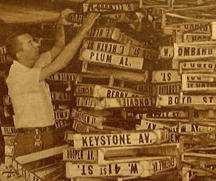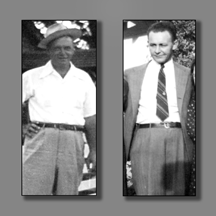Updated September 25, 2023
Copyright 2011-2023 Susan Burneson. All rights reserved. Please talk with us before reproducing any website content.
Our series on Central Austin street names—how they were named and what some of them once were called—continues.
KAREN AVENUE—Named for a niece of Dr. Joseph S. Koenig. (See Koenig Lane, below.)
KOENIG LANE—The first known description of the street appeared in the Austin American-Statesman on November 21, 1936: “the public lane sometimes known as Koenig Lane.” It finally was paved in 1953. Named for Dr. Joseph Samuel (J. S. or Joe) Koenig (1885-1951), a chiropodist, insurance executive, and real estate developer. In the 1920, Dr. Koenig and his wife, Lera Lynn, owned property in at least four subdivisions in the vicinity of what would become Koenig Lane—Koenig Place, Koenig Terrace, Murray Place, and Northfield (they also owned property in Arboles Terrace, south of Barton Springs Road). In 1937, an ad in The Austin American advertised “bright cane and Johnson hay” for sale or trade at the Koenig Farm on Fiskville Road (today’s North Lamar), likely also was owned by Dr. Koenig’s family. According to another researcher, the farm possibly was near the Texas Department of Public Safety property at today’s North Lamar and Koenig Lane. By 1946, Dr. Koenig and Clarence McCullough developed Section 1 of the Violet Crown Heights subdivision, north of Koenig Lane between Payne and Ruth in the Brentwood neighborhood. (See the 1947 promotional flyer for Violet Crown Heights here.) By 1948, Dr. Koenig and Mr. McCullough developed Section 2 of the subdivision, from Payne to Koenig Lane. By 1950, they developed the Violet Crown Shopping Center. Dr. Koenig died in 1951. More about both of them here.
LERALYNN STREET—Named for Dr. Joseph S. Koenig’s wife, Lera Lynn. The street is located east of Lamar and north of 51st Street, near other property owned by Dr. Koenig and his wife.
McCANDLESS STREET—Named for Lindon Leslie (Dude) McCandless, who developed a number of properties on the street in the 1940s, in addition to the Burnet Heights (now Northwest) Shopping Center, and Burnet Heights Subdivision east of the center, all in Brentwood. More about his other Austin-area projects here.
 NORTH LAMAR BOULEVARD—Named for Mirabeau B. Lamar, second president of the Republic of Texas, 1838-1841, and known as the father of education in Texas. Once the main road between Austin and Dallas before IH-35, North Lamar was known by other names over the years: State Highway 1, Lower Georgetown Road (Burnet was Upper Georgetown Road), U. S. Highway 81, Fiskville Road, and the Dallas Highway. Fiskville was an early community on Little Walnut Creek, six miles north of Austin.
NORTH LAMAR BOULEVARD—Named for Mirabeau B. Lamar, second president of the Republic of Texas, 1838-1841, and known as the father of education in Texas. Once the main road between Austin and Dallas before IH-35, North Lamar was known by other names over the years: State Highway 1, Lower Georgetown Road (Burnet was Upper Georgetown Road), U. S. Highway 81, Fiskville Road, and the Dallas Highway. Fiskville was an early community on Little Walnut Creek, six miles north of Austin.
RICHCREEK ROAD—Named for Frank Richcreek, who owned a large dairy farm from Justin Lane to Anderson Lane. Back then, it was outside the Austin city limits. In 1947, the Richcreek land began to be developed as the Crestview neighborhood. (See a video clip of neighbor John Carlson, who remembers Mr. Richcreek and his red dairy barn, here.) Richcreek’s farmhouse, originally near what is today the northwest corner of Justin and Lamar, was moved in 1947 to 1405 Justin Lane, where it stands today.
RUTH AVENUE—Named for Clarence McCullough’s wife, according to their son Chuck (Charles McCullough). (See Koenig Lane, above.)
RYAN DRIVE—Likely named for George L. Ryan, who was working in the A. B. Beddow real estate agency at least from 1947 to 1949, according to local newspaper classified ads. In 1947, Crestview began to be developed by A. B. Beddow and Ray Yates from Justin Lane north to Anderson Lane. Ryan is listed in quite a few Austin real estate ads in 1951 as “G. L. Ryan Real Estate.” Local classified ads show him as being with the Geo. W. Sandlin Co. at least from 1952 to 1954. When he died in 1963, his occupation is listed as owner of Western Fence Company and real estate. He was living at 704 Laurel Valley Road in West Lake Hills at the time of his death.
“SAINT STREETS”—Four Crestview streets south of St. Louis King of France Catholic Church have “saint” names—St. Cecilia, St. Joseph, St. Louis, and St. Philip. When we interviewed Mickey Bauer for our oral history project in 2010, she shared a story she had heard about the naming of the streets. She was an original member of the church when it was established in the early 1950s. She has lived in the vicinity for more than 80 years, first on a farm that later became part of Brentwood and later in a home near the church. Mickey said Eddie Joseph (Edward William Joseph, 1901-1985) owned property around the church (along with many other real estate holdings around Austin, including the local North Austin Drive-in). She heard that when the “saint” streets near the church—Cecilia, Joseph, Louis, and Philip—were named, Joseph was so rich he named them for his family. It sounded like a good story, and maybe there’s some truth to it. In 1930 census records, Eddie Joseph’s family includes a brother Philip Lawrence Joseph and a sister Cecilia Joseph Norton, among other siblings. Louis A. Joseph was Eddie’s nephew. Another possibility—St. Louis St. was simply named for the nearby church; the original building near the north end of that street. Eddie and his siblings’ father Cater Joseph emigrated from Lebanon in 1872. More about Cater Joseph’s and his family’s many contributions to Austin here.
TISDALE DRIVE—Named for the Tisdale family who once owned a large farm north of Anderson Lane in what is now the Wooten neighborhood. Stock farmer Dick Dudley Tisdale, his wife Lilly, and daughters Lily and Alma lived there. Their address in 1930 was Lower Georgetown Road (today’s North Lamar). In 1953, Dick’s father, a retired rancher, lived nearby at 904 Stobaugh. In the early 1960s, Anderson Lane was still a two-lane dirt road. To the north, site of the Tisdale farm, people remember seeing barbed wire fences, barns, cows, and hay. One neighbor who grew up on Morrow Street in the 1950s and early 1960s remembers visiting the Tisdale home and staying after school with the Tisdales’ two married daughters, Mrs. Purdy and Mrs. Sylvester, who lived nearby. Dick and Lilly Tisdale’s original farmhouse no longer exists. They built the stone home at 7904 Tisdale in 1945, where they lived as they grew older. Dale Drive, near Tisdale Drive, was named for Dick and Lilly’s grandson Dale Sylvester. He owned a construction company, and the Sylvesters’ home and his business also were on Tisdale Drive.
WILLIAM HOLLAND DRIVE—Holland was born into slavery in Texas and fought in the Union Army during the Civil War. Later, he was elected to the Texas House of Representatives; was the first black person to be elected to the Travis County Commissioners Court; and helped establish the Deaf, Dumb and Blind Institute for Colored Youth in Austin and was its first superintendent. The institute later became part of the Texas School for the Blind and Visually Impaired. Formerly, the street’s name was Jeff Davis Avenue, named for Jefferson Davis, president of the Confederacy. The name was changed to William Holland Drive in April 2018.
 YATES AVENUE—Named for Ray Yates, who developed Crestview and the shopping center with A. B. Beddow (Beddow and Yates in photo at right). According to neighbor Louise Cooke, the city bus once ran along Yates. Ray and his wife Maude lived for many years on the southeast corner of Woodrow and Richcreek. (See also the Justin Lane story here.)
YATES AVENUE—Named for Ray Yates, who developed Crestview and the shopping center with A. B. Beddow (Beddow and Yates in photo at right). According to neighbor Louise Cooke, the city bus once ran along Yates. Ray and his wife Maude lived for many years on the southeast corner of Woodrow and Richcreek. (See also the Justin Lane story here.)
Thanks to John Carlson; Louise Cooke; J. D. Harper, Crestview Pharmacy; Beverly Lester; Chuck McCullough, Violet Crown Shopping Center; Ronnie Prellop, Crestview Minimax; and other neighbors for sharing what they know about Central Austin streets. Online and printed sources of information include Ancestry.com, Austin History Center, City of Austin, U. S. Federal Census, and others.
